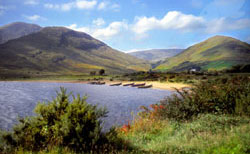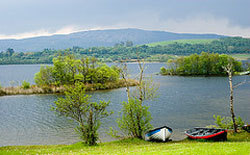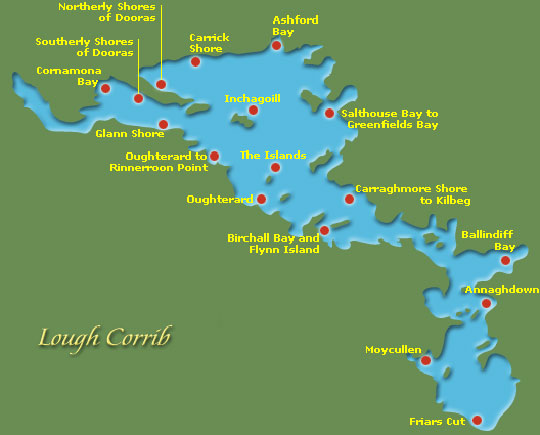|
General
Loch Corrib, which is the second largest sheet of inland
frest water in Ireland, is about thirty-five miles in length
from Galway to Maam and varies in breadth from eight miles,
as between Oughterard and Cong, to one quater of a mile, as
from the Wood of Dun to Corran Point, where it narrows
between the
Joyce Country and the Iar-Chonnacht hills. Its
general direction is from west-north-west, in a curvature,
to south-south-east. In depth it varies considerable. It is
in many parts full of rocky shoals, dry in summer; and even
in the navigation course, having but six or seven feet of
water in some places.
 |
 |
Fishing
Lough Corrib is one of the best game fisheries in the world
and it is a wonderful place to experience what Ireland has
to offer both in terms of the game angling and the
hospitality of the local people. It is a vast lake of 44,000
acres and stretches some thirty five miles from Galway City
to Maam Bridge. Because of its size and numerous underwater
hazards it is very advisable to use a guide on your first
few visits, until you feel comfortable and confident enough
to rent a boat yourself. The use of a guide also has the
benefit of getting you to the best and
most productive fishing grounds straight away, hence making
your day more productive and enjoyable. More on
Fishing Lough Corrib
Islands
Lough Corrib is reputed to have 365 islands. Most famous of
which is Inchagoill Island. Located midway between Cong and Oughterard, it is one of the largest of the many wooded
islands along Lough Corrib. The island has spectacular views
of the Maumturk range. Joyce Country and the mountains of
Connemara, and it is also home to two ancient venerated
sites, set close together in its woods' St Patrick's Church
believed to have been erected in the 5th century and the
tiny 12th century Church of the Saints. There are secluded
beaches and enchanting woods with a variety of walks around
the island. There is evidence of an early monastic
settlement which still mostly remains a mystery. There are
two churches remaining, St. Patrick's and the 12th century
church known as the "saints" church. There are several paths
around the island, an old cemetery and remains of four or
five cottages which housed the few inhabitants on the
island.
Maps
 |
Rivers
Lough Corrib drains via the Corrib River through Galway
City into Galway Bay.
The main rivers into Lough Corrib include the River Clare
and the
canal through the village of Cong, which joins Lough Mask to Lough Corrib.
Cruises
From Cong Corrib Cruises run cruises on board "The Lady
Ardilaun" from Ashford Castle to Inchagoil island and
Oughterard. This Cruise takes you on a very scenic voyage.
We cruise beautiful Lough Corrib with guided commentary of
islands, lake and shoreline. There are also other cruises
available.
From Woodquay in Galway City you can enjoy the relaxed
atmosphere of a cruise with us on board the luxurious Corrib
Princess. The journey takes passengers along the majestic
River Corrib and onto the lake providing visitors with
unsurpassed views of the historic monuments and natural
amenities that make this the most spectacular waterway in
Ireland. The Corrib Princess takes you past castles and
various sites of both historical interest and natural
beauty. There is an abundance of wild life and the Corrib
has a peace and tranquillity all of its own.
Wildlife
There is an abundance of wildlife in Lough Corrib including
birds and hawks, otters, mink, stoat, frogs, bats and much
more. The "Dawn Chorus" in early spring is spectacular to
listen to. Lough Corrib can be divided into two parts: a
smaller shallower basin to the south and a larger deeper
basin to the north. These two parts are connected by a
narrow channel. In the southern and eastern parts of the
lake the lake bed is dominated by limestone bedrock covered
by deposits of precipitated marl. The surrounding land is
mostly pastoral farmland to the south and east and bog to
the west and north. In addition to the lake basis, some
areas of scientific interest adjoining the lake e.g.
woodland, callows grassland and raised bog, have been
incorporated into the site. The lake supports one of the
largest areas of wetland vegetation in the country. This
vegetation is best developed in the shallower southern basin
of the lake just north of Galway city. The shallow lime-rich
waters in this area support the most extensive beds of
Charaphytes in Ireland. These beds are an
important source of food for wildfowl.
Tour Lough Corrib
Corrib Country Tour (140km / 88miles)
The route includes ; Galway City - Moycullen - Oughterard -
Maam Cross - Maam - Cornamona - Clonbur - Cong - Headford -
Galway City.
This tour follows the 140km shoreline around lough Corrib.
Environmental Issues
The uncontrolled discharge of sewage, particularly into the
southern part of the lake, is causing nutrient pollution.
Other threats to habitat quality are wildfowling (causing
disturbance to birds) and increasing pressure from fishing
and from lakeshore developments such as hotels, holiday
homes and marinas.
The Zebra Mussel - a native of the Black and Caspian Seas -
which has already colonised the Erne and Shannon waterways
is highly destructive to various fish species including the
world famous wild brown trout of Lough Corrib. Zebra mussels
can filter as much as 1 litre of water per day through their
gills. They remove phytoplankton, small zooplankton and
bacteria amongst other things. As a result of this activity,
the food web of their new habitat is changed. Studies have
shown that this leads to reductions in different populations
of fish. Zebra mussels attach onto the shells of swan
mussels, preventing them from feeding, resulting in death of
the swan mussels.
|


